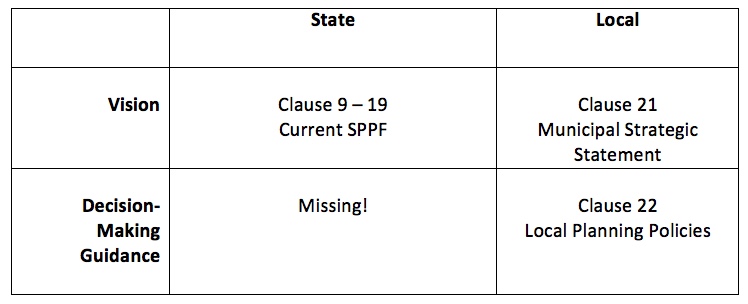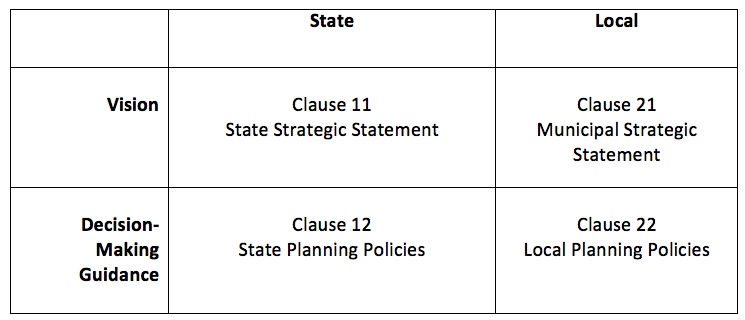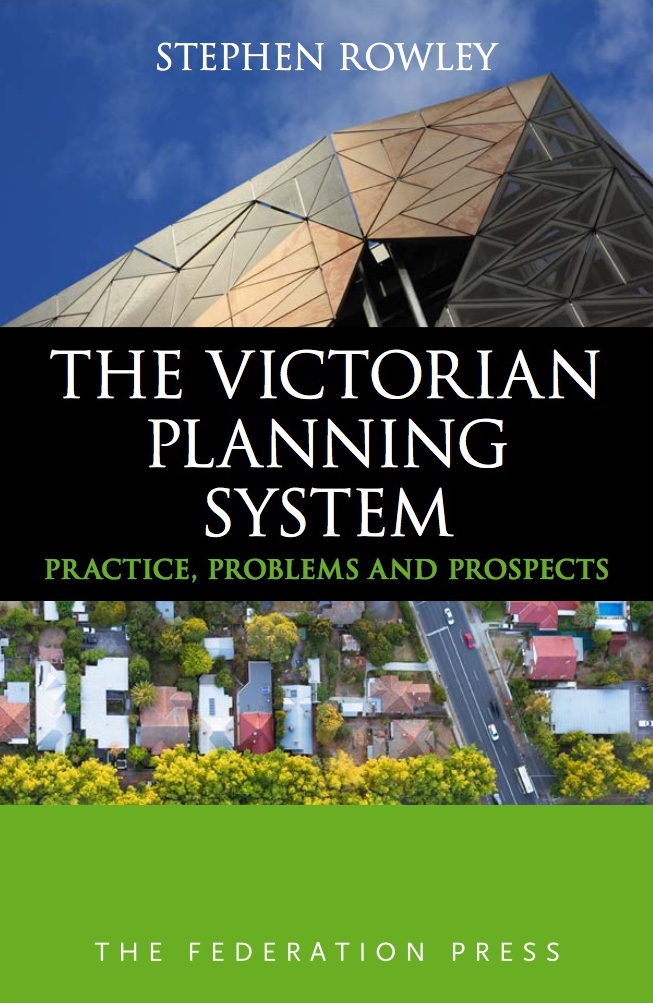 This article comments on the publicly available material about DELWP’s Smart Planning program as of late March 2017. It is adapted from comments previously provided to DELWP about their proposed work program. I have updated those comments to serve as background and supporting material to my presentation at a VPELA seminar on Smart Planning on 27 March 2017.
This article comments on the publicly available material about DELWP’s Smart Planning program as of late March 2017. It is adapted from comments previously provided to DELWP about their proposed work program. I have updated those comments to serve as background and supporting material to my presentation at a VPELA seminar on Smart Planning on 27 March 2017.
It is generally accepted that there is a need to reform the Victorian planning system. This has been couched in terms of varying urgency by various system review over the life of the system. The recent release of a scathing VAGO report into the system – which amongst other things noted the lack of action in response to its similar 2008 review – has increased the sense that the need for reform is more urgent than some previous reviews have acknowledged.
In response to such criticism, the government can point to the existing Smart Planning reform program as a sign that a response is in hand. Yet how likely is this program to address the existing problems? Is it focussing on the right problems or the most constructive solutions? I am concerned that the focus of the early stages of Smart Planning, in particular, are poorly thought out and directed. The comments below outline some concerns with the traditional focus of reform in Victoria – which largely align with the Smart Planning work program – and then try to suggest some more productive approaches.
For brevity at various points I have made reference to arguments I have outlined in my book The Victorian Planning System: Practice, Problems and Prospects. This is cited as VPS-PPP.
Scoping
Diagnosis necessarily precedes cure. The existing Smart Planning material underpinning the early stages of the program – as opposed to the more exploratory “Transform” phase – gives little sense of diagnosis of problems or the broad-based consultation that characterised the earlier VPSMAC / Underwood review. This leads to a feeling that various avenues are being pursued without adequately identifying whether they will actually solve the problems, or even being clear what the problems are.
The VPSMAC represented a good broad-based opening scoping paper to this kind of review. If that scoping work can’t be redone then it is suggested that their work be more clearly “owned” as a predecessor to this project, and some sort of position paper be prepared in response to it.
The limited currently available information on the Smart Planning website is disappointing given the apparent pending gazettal of working provisions. In particular VicSmart has been announced for extension, without any detail. As argued below VicSmart extension is in my view a serious mistake.
More generally, it is difficult to reconcile such announcements with the document about engagement that has been posted on the Smart Planning website. While targeted consultation has been undertaken on VicSmart, no copies or even summaries of submissions or findings from that consultation has been released. Committing to an extension of VicSmart before release of any such material undermines the sense that the process is genuinely open.
Unproductive and Counter-productive Avenues
VicSmart
VicSmart is an unhelpful and poorly structured mechanism that complicates simple assessments and day-to-day system administration, without offering any tangible assistance in achieving the time savings it demands of local government (see VPS-PPP pages 137-141). The complexity it adds to processes is a barrier to future reforms such as automated “do I need a permit / how do I lodge” assistants. A genuinely broad-based system streamlining project would remove it in favour of targeted exemptions and streamlining of core VPP provisions.
Expansion of the program at this point would be counter-productive, even as an interim measure. Better, readily-implementable streamlining alternatives exist, as outlined below.
Issues with Specific Proposed VicSmart Triggers
Previous announcements have identified the following as VicSmart triggers:
- Minor buildings and works associated with a non-residential use in residential zones, with a cost of development up to $100,000.
- Single storey extension to a single dwelling on a lot less than 300m2(or 500m2) where ResCode objectives and standards at clauses 54.03, 54.04 and 54.05 are met.
- building and works up to $1 million in industrial areas
- building and works up to $500,000 in commercial and some special purpose areas
- a range of low impact developments in rural areas (up to $500,000 in agricultural settings and $250,000 in more sensitive rural settings)
- small scale types of buildings and works in selected overlays
- subdivision, advertising signs and car parking.
In addition to the broader fundamental concerns with VicSmart, most of these triggers are considered especially ill-suited to inclusion in VicSmart.
While a full account of the problems with these triggers is beyond the scope of this article, problems include:
- The categories do not align with complexity of assessment with any reliability.
- The cost-related triggers are subject to abuse and manipulation since it is difficult to verify costs of works.
- The cost-related triggers exacerbate the problem of incentivising fragmentary applications that VicSmart’s existing streams already create.
- The specified clause 54 provisions include qualitative standards and objectives. The legal status of an application cannot be tied to qualitative controls; this offends basic principles of statutory drafting.
- Even if aligned only with quantitative standards, the clause 54 category would be too hard to triage at lodgement. It requires a full assessment against three ResCode clauses involving multiple standards at time of lodgement to identify the application category. This will cause considerable operational difficulties and require counter-productive reallocation of resources.
- The ResCode category will lead to many poor outcomes if it is effectively taken as a given that development should proceed if it complies with quantitative standards.
- Alternatively, if the control is framed so that discretion still exists to find the proposal unsatisfactory if the qualitative outcomes are not met, councils would be left having to refuse applications in the VicSmart timeframe. This is a poor outcome. In such cases the VicSmart process would preclude genuine attempts to resolve issues. The problems involved with fast-tracked refusals are already a problem with the wider VicSmart program.
- The ResCode category misuses standards that were not designed as deemed-to-comply provisions. The standards were designed with the assumption that they would require alteration in either direction (eg either greater or lesser setbacks) based on contextual factors (see VPS-PPP pps 215-219). To declare anything within these standards as fast-trackable misunderstands the line in the sand that was originally drawn by these standards.
- If it is the intent to alter the ResCode standards to work as deemed-to-comply provisions despite the objections above, the appropriate mechanism is to make it as-of-right and manage it through building controls and report-and-consent arrangements.
- The industrial categories seem likely to increase scope for error in missing interactions with other legislation and requirements, such as EPA works approval and referral requirements. Clearly VicSmart wouldn’t override these; but it does increase the chances that such applications are handled by rushed and inexperienced staff, increasing chances of such interactions being missed.
- The rural category, as described, could include all sorts of inappropriate works.
- The rural category raises particular difficulties in organising site inspections within ten days in rural councils given the distances involved; this is likely to lead to skimping on assessment.
The VicSmart categories include many categories of application for which there have been longstanding calls for review of the core VPP controls, such as car parking, signage and heritage. To fail to complete or implement those reviews over decades but then demand faster assessments from local government is objectionable. Such reform approaches reflect and entrench a breakdown of understanding of the dynamics of the assessment process at state government level.
 Code Assessment
Code Assessment
Code assessment has long been a key element of the planning reform agenda, notably because of its endorsement by the Development Assessment Forum. Code assessment as originally outlined in the DAF model makes more sense in other jurisdictions, where the imposition of a state-authored code is a means to override local controls. In the VPP model it is hard to see what purpose it serves (see VPS-PPP pp 133-137). If truly objective tests can be identified, these should be structured as exemptions, not a separate assessment process. Code assessment has been at the centre of system reform efforts for much of the last decade, and has been subject to repeated pilots, but has not yet yielded an implementable model (VicSmart is a merits assessment system). This should tell us something!
Furthermore, it is worth noting that older system reviews favoured the more productive approach of using code-assessment-like tests as a basis for permit exemptions, rather than fast-track assessments (see Better Decisions Faster, page 21). Despite overt support for Code Assessment, the initial VPSMAC report showed some signs of coming back to this perspective at the urging of local government (see page 133 of the Underwood review). This is a better approach.
It is worth noting that on the same page that review specifically cited flipped overlays (discussed later in this document) as one alternative approach.
System Streaming
The notion of system streaming is, largely, based on a “straw man” idea that all applications proceed along the same assessment path. The persistence of this idea is puzzling since as I note (VPS-PPP p 135) the current system allows variation of whether notice is able to be given, extent of notice, referrals, appeal rights, assessment tools, delegation and decision-making arrangements, and the responsible authority.* Furthermore it allows on-demand mixing and matching of these settings, whereas “streams” inherently involve bundling groups of settings.
There is some scope for additional customisability, but discussion of streaming needs to acknowledge that:
- Varied system streams already exist, but are based on an “unbundled” choose-your-mechanism model.
- Bundled streams as proposed in various previous system reviews are for the most part less flexible than the current arrangements.
The main scope for improvement in this space, in my view, is the use of 30, 60 and 90 day statutory timeframes, especially if paired with a mutually agreed on-hold mechanism.
Integrated PPF
This isn’t a bad idea, as such, but it is a low yield reform that cuts across other potential improvements (discussed later in these comments). There is an inherent (and non-trivial) opportunity cost related to the strategic work associated with restructuring the LPPF of 79 different schemes. Does a content-neutral restructure of schemes yield benefits commensurate to the extent of strategic resources diverted to the task? If so, how? Some of the problems the original PPF model was solving – such as number of pages in the SPPF frameworks from the inclusion of irrelevant regional material in all state schemes – have receded in importance with the decline of the use of hard-copy schemes.
The associated rewrite of the schemes could be a good opportunity to rationalise and re-write controls, but if this is the real benefit then that should be the main focus of the SPPF/LPPF/PPF review, and it is more important to focus on agreement on the nature and approach to that task. Integration, if pursued, would be a secondary goal.
Streamlined SPPF/LPPF and Collapse of Clause 21 and 22
Ever since the Making Local Policy Stronger review there has, somewhat ironically, been constant pressure to slim down local state and local policy and use other tools to do its job. The supplementing of policy with other supportive tools is helpful but unfortunately this has perversely only entrenched the sidelining of policy as a tool: it has increased the view that if something is really important another provision (an overlay, a zone schedule etc) will be used. This is unhelpful because for certain things policy is a very useful tool.
One side effect of this marginalisation is a continued focus on streamlining policy. The integrated PPF is one sign of this; the approach taken to many LPPF reviews of removing clause 22 policies and relying more on the MSS is another. In my view such thinning very often misdiagnoses the problem. I am critical in my book (p 107) of repetitious policies that fail to progress from vision to decision-making guidance, and simply restate high-level guidance in different formulations. However the problem here is not the length of policies per se, but the lack of progression in them. This largely derives from directives about scheme drafting that are actively hostile to the resolution of policy (see VPS – PPP p. 106).
“Streamlining” policy, if not undertaken with a very clear emphasis on improving policy resolution, threatens to further undercut it. For example, thinning clause 22 policies in schemes tends to weaken the more directive (and hence most useful) aspects of policy. Improving policy resolution may actually involve adding to policy to improve its focus (though I don’t doubt that much can also be trimmed from many policy frameworks).
Streamlining needs to be carefully situated within a carefully defined philosophy of regulatory design; and careful structural reform. I suggest models for both below.
More Productive Avenues
The following emphasises things that I think are:
- Readily implementable, including short-term easy wins.
- Suitable for badging under Smart Planning.
- Scalable to also include longer term review and structural changes.
- More productive alternatives to those approaches already discussed.
In addition to these comments, and my book, I have written on such system reform measures in the articles listed at the conclusion of this article.
Flipped Overlays / System Targeting
Flipping the building and works trigger in overlays, so that schedules needed to specify what needs a permit, is a simple but potentially profound structural improvement. It instantly forces controls to be more precisely targeted, improving the quality of controls. The Underwood review quoted my comments on this topic at some length (see pages 105–6).
The initial stage of this is extremely easy to implement. The text in the core provision of overlays could simply be changed to wording that only affects new schedules along the following lines:
A permit is required to construct a building or construct or carry out works where the schedule to this overlay was introduced before [date]. This does not apply if a schedule to this overlay specifically states that a permit is not required.
A schedule to this overlay introduced after [date] may specify permit requirements for buildings and works.
In a worst-case scenario well-progressed amendments could simply use the current all-in trigger aporoach in their schedules; however it would be hoped that quite quickly new amendments would be expected to be more precise and targeted. An advisory note could guide how quickly it was expected that new amendments be fully targeted.
I would suggest this should be sold as part of Smart Planning under the banner of “system targeting,” with a possible roll-out progressing something like this:
- Immediately: Revised overlay text as outlined above.
- Medium term (1 – 2 years?): Work with councils to revise existing schedules to be more targeted. The goal should at some point be to ensure all new schedules complied so that after c. 3 years the interim date-based wording in overlays could be removed.
- Medium – longer term: VPP audit to target other VPP clauses with similarly wide triggers (for example, the very broad buildings and works triggers in the Commercial and Industrial Zones).
As an aside, I find it very difficult to envisage how the latter stage would not involve rolling back VicSmart, as such streamlining and targeting of core VPP controls would logically either remove VicSmart categories or collapse their assessment back into the core control.
In the latter part of this article I have suggested a restructuring of HOs as part of a broad reform pipeline. While that project would be something slightly different, it has conceptual similarities and could be badged as part of this project.
Targeted Locally-Driven Exemptions
The idea here is to give councils a genuinely facilitative tool that can identify specific categories of application that they feel they don’t need to see: e.g. simple dual occupancies or infill units that they are likely to be very comfortable with; or additions within certain portions of properties (e.g. the “traditional” or non-sensitive envelope in a street of highly consistent forms, such as terrace houses). I would envisage two broad types of usage:
- Localised permit exemptions based on examination of spatial characteristics. Here councils would do street-by-street work and identify envelopes for streets in which buildings were acceptable.
- Broadly applied exemptions that work basically everywhere. Eg perhaps an exemption for “Fonzie garages” and other low impact projects.
The former encourages more spatially resolved policy setting and facilitation; the latter could potentially become a laboratory for councils to pioneer exemptions that could be used state-wide.
I have drafted an initial version of such controls, based on hanging off the permit triggers for residential development: see http:www.sterow.com/pdos for draft text. The same principle could be extended to other triggers (eg Commercial and Industrial Zones) easily enough.
Again, a scalable work program for this would be something like:
- Immediately: Add the tool to the VPP toolkit.
- Short-medium term: Encourage councils to consider ways to use the tool; obviously to implement them they’d need to talk to DELWP who can then compare and share solutions. This becomes a form of regulatory crowd-sourcing.
- Short–medium term: In parallel, DELWP develop possible models of its own. Combined with the above, the idea would be to develop a menu of possible uses of the tool.
- Medium-Longer term: If take-up is low (or some councils are recalcitrant) and there are applications state government is very confident in, these can potentially be applied by DELWP as GC amendments. Hopefully it wouldn’t come to that.
There is more detail on this model in the article cited above.
Scheme Language: Clarity and Certainty
I am very critical of the prevailing approach to scheme drafting in Victoria (see VPS – PPP pp 106-108 and 279-280, and my comments quoted by the Underwood review at pp 107-108). While themes of improving clarity and certainty of policy expression recur in previous system reviews, in my view these have generally pulled their punches and stopped short of stating how dysfunctional the current modes of policy expression and regulatory design have become.
It is time to be more assertive about this, more clearly acknowledge there are fundamental problems with the current approach, and re-work the various practice notes and guidelines about scheme drafting. While I can’t do justice to the changes needed here, critical points would be:
- Increased focus on the full suite of levers available (eg making things as-of-right; and discussion of when to use which parts of the scheme) rather than prioritisation of strategy-led exercise of discretion (which encourage system bloat). See VPS-PPP pp 99-101.
- Clearer delineation of types of regulatory mechanisms used (for example breaking down the false association between performance-based and subjective controls). See VPS-PPP pp 101-106.
- Endorsement of different approaches to achieve different types of policy objectives, and discussion of when to use what approach. For example, if consistency of height is appropriate, mandatory height controls may be the best tool. The emphasis one on preferred “recipe” (subjective, discretionary, strategy-led controls) in Victoria has been unhelpful.
- Emphasis on resolving competing policy dilemmas, rather than simply listing them.
- Emphasis on spatial resolution of policy.
- Emphasis on top-to-bottom regulatory design. The current system encourages a “put it in the SPPF or LPPF and the job is done” approach. The aim should be to encourage policy to be accompanied as much as possible by resolved regulatory expression.
- Stronger directives against what I call SNORDs: stand-alone non-regulatory documents. Councils and the state government waste time on preparing stand-alone strategies and structure plans (including things like Plan Melbourne) and then take years to sort out scheme “translation.” This is incredibly wasteful. Work like that should always either be included fully in the scheme, or at least have scheme text prepared as part of the primary project output.
A clear expression of intent on this front could be announced in the short term with a suite of new practice notes released in the medium term.
Universal Policy: Clause 11 and 12
As I have noted elsewhere – pp 282 of my book, plus Rowley (2015) and in most detail here – the SPPF currently only includes the state-level equivalent of the LPPF’s MSS at clause 21: i.e. broad vision-setting. What it lacks is actual decision-making guidance akin to the LPPF’s clause 22. This is leading to councils writing local policies for universal dilemmas, which is inefficient and leads to consistency problems.

That’s a key reason why I’m sceptical about the previously proposed integrated PPF. While not strictly contrary to the development of SPPF decision-making guidance, it certainly would distract from the objective. Much more helpful would be to make the structure of the SPPF analogous to the structure of the LPPF. So it would include clause 11 (the current SPPF, structured akin to an MSS) and clause 12 (universal decision-making guidance, akin to clause 22), as per the diagram below.

Examples of such universal policy for clause 12, currently covered in many councils’ clause 22, would be:
- Heritage (outlining general principles of heritage design, based on existing local policies, and other documents such as Heritage Victoria’s Guidelines for Assessing Planning Permit Applications).
- Urban Design (as suggested, it could be along the lines of Melbourne’s Clause 22.17 and incorporate material from various state government urban design publications)
- Discretionary Uses In Residential Zones (many councils have such a policy, and there are many shared elements across such policies).
- Safer Design (if not addressed in the Urban Design policy suggested above)
- Advertising Signs
- Sustainable Building Design
This would also help to halt the spread of awkward stand-alone documents such as the Better Apartments document. These are a recipe for terrible drafting as their stand-alone nature obscures their regulatory purpose. These should be either in Particular Provisions or the proposed Clause 12.
If an integrated PPF was really desired, you could blend that with my model and have clause 10 – Integrated State and Local Vision and Clause 20 – Integrated State and Local Policy. I don’t really advocate that for the reasons mentioned earlier (it is a bigger restructure than you need for little apparent benefit) but it certainly could be done.
A work program for a clause 11 and 12 model could involve:
- Short term: Release details of proposed structure and ask for comment, and suggestions for universal content.
- Short-medium term: sweep existing council policies and response to above, and identify key common themes in universal clause 22 policies as the skeleton for the state versions. When I was at the Department we informally did a similar exercise informally when revising the advertising signs Particular Provision. It was both relatively simple to do and highly rewarding in terms of quality content it unearthed.
- Medium Term – Introduce the new structure, with an identified pathway for revision of existing local policies.
System Monitoring and User Feedback
The Auditor General’s 2008 review of the planning system made recommendations regarding Departmental performance monitoring and stakeholder engagement that have never been properly acted upon (see here, pages 48–49). Those recommendations need to be implemented in full. In particular, there needs to be a focus on:
- Measuring system efficacy, rather than simply throughput.
- A structured approach to system feedback and stakeholder engagement. This could include processes for user suggestions to the system that were responded to in an accountable manner and would feed into the Reform Pipeline (see below).
- A regular program of monitoring VCAT decisions and communicating publicly whether they accord with Departmental intent, and hence whether there will be a Departmental review of operation of provisions. VCAT can assist with this by flagging decisions they consider warrant Departmental attention (this is distinct from the function of existing Red Dot decisions).
As an example, the issue of scheme interpretation addressed at pages 216-219 of my book – about application of ResCode standards – arose twelve years ago and has never been subject to Departmental response; multiple attempts to get the Department to even acknowledge the issue have been met only with obfuscation. This is simply unacceptable.
See pages 282 – 285 of VPS – PPP for more on performance monitoring.
A Reform Pipeline
There are many less glamorous reforms that tend to be missed in reviews like this because they don’t cohere well into a project work program and are hard to sell as a branded initiative. These include both easy wins and longer term projects, including things that may simply be worth investigating. However these can be badged as part of Smart Planning through announcement of a Reform Pipeline, which allows these to be put under one umbrella.
To make this identifiable as a concrete initiative you need a few structural things:
- A dedicated website on the planning portal. Give it its own friendly URL (planning.vic.gov.au/reformpipeline or similar)
- A structured submission process for suggestions.
- A list of projects as a starter, outlining things in the reform pipeline – suggestions below.
- A policy about communicating outcomes. Previously, un-enacted reforms would tend to disappear from the Department’s website when they got too old and embarrassing. The commitment here should be that while programs might drop from the Pipeline, there will at least be a public and archived explanation of why. There should also be a commitment to one-on-one communication of why items suggested for the pipeline are rejected.
Some examples of the kinds of more ad hoc changes that would be candidates for the Pipeline (many of these are from my 2015 piece on system reform):
- Fixing the Act to allow advertising to only parties identified as suffering material detriment.
- An on-hold mechanism where statutory timeframes are suspended by mutual agreement between RA and applicant (to allow resolution of issues and avoid hair-trigger refusals where genuine will to resolve the issues exists).
- A mechanism to fix technical errors in an application without stopping the clock.
- Three classes of statutory timeframe for different triggers (I suggest 30, 60 and 90 days). Realistic timeframes equate to better compliance with timeframes which ultimately better serves all system users.
- A more thorough review of statutory timeframes to remove perverse incentives and unfair practices. Eg stop the advertising period from being counted (including time taken for the applicant to return statutory declarations), but offset that by not resetting time to zero for receipt of further information.
- Repeal S 115CA of the VCAT Act! This is an astonishingly obnoxious piece of legislation.
- Prevent the use of secondary consent to create one unified process for permit amendments, as previously proposed in Modernising Victoria’s Planning Act. See pages VPS – PPP 154-158.
- Stop covenants from trumping planning considerations – an outcome that is the exact reversal of the original legislative intent. See pages 143-148 (and the sources cited in that discussion).
- Targeted exemptions for simple parking waivers (eg in existing tenancies in commercial zones, or on sites below a specified size where less than a certain floor area of new works are proposed).
- More broadly, review the use of minimum car parking controls as a mechanism – it is a discredited tool. See VPS – PPP pages 27-274.
- Review 52.27 and clarify the roles of liquor licensing versus planning (my view is planning’s role is best managed through the table of uses and 52.27 serves no valid planning purpose).
- HO restructure to allow separate schedules that are more precise about what needs a permit, similar to flipped overlays. Consider separate treatment of precincts and individual places: perhaps the former are listed in one table as they are now, and places broken out in separate schedules.
- Planning scheme text served in a readily cut and paste-able format. This would change my life.
The list would also be a parking spot for the countless little small fixes included in regular VC fix-up sweeps – from this perspective it helps to publicise what the Department already is doing to improve things.
Conclusion
There are plenty of achievable, politically palatable easy wins that would make a substantial improvement to the system and which could form the basis of Smart Planning. Unfortunately Smart Planning’s early stages have – presumably to achieve some early perceived easy wins – focussed disproportionately on previously tried or half-implemented models. Most of these are low-yield returns; some are actively counterproductive; and some will cut across more productive reform measures.
Smart Planning needs to pause and better define its direction. There are better models, and current actions will make it harder to implement these.
* That’s only considering avenues in the permit process. More broadly, there is also the choice of permit process, amendment process (facilitating multiple different methods of defacto approval), combined permit and amendment process, environmental impact assessment, and multiple paths under the MTPF Act.
Further Reading
A lot of the above draws on things I’ve written elsewhere. Obviously there’s my book, which you can read more about at www.sterow.com/vicplanningbook.
 Shorter articles I have authored or co-authored on system reform include:
Shorter articles I have authored or co-authored on system reform include:
It’s Not so Hard: Ten Simple Planning System Fixes (2015).
Preferred Development Overlays: A Better Way to Facilitate Development (2014).
Fixing the Victorian Planning System: Six Key Issues (2011).
Fixing the Planning & Environment Act (2009).
Building a Better System (2008).
Images by Jes and mugley from flickr, used under creative commons licence. Click on them for detail.